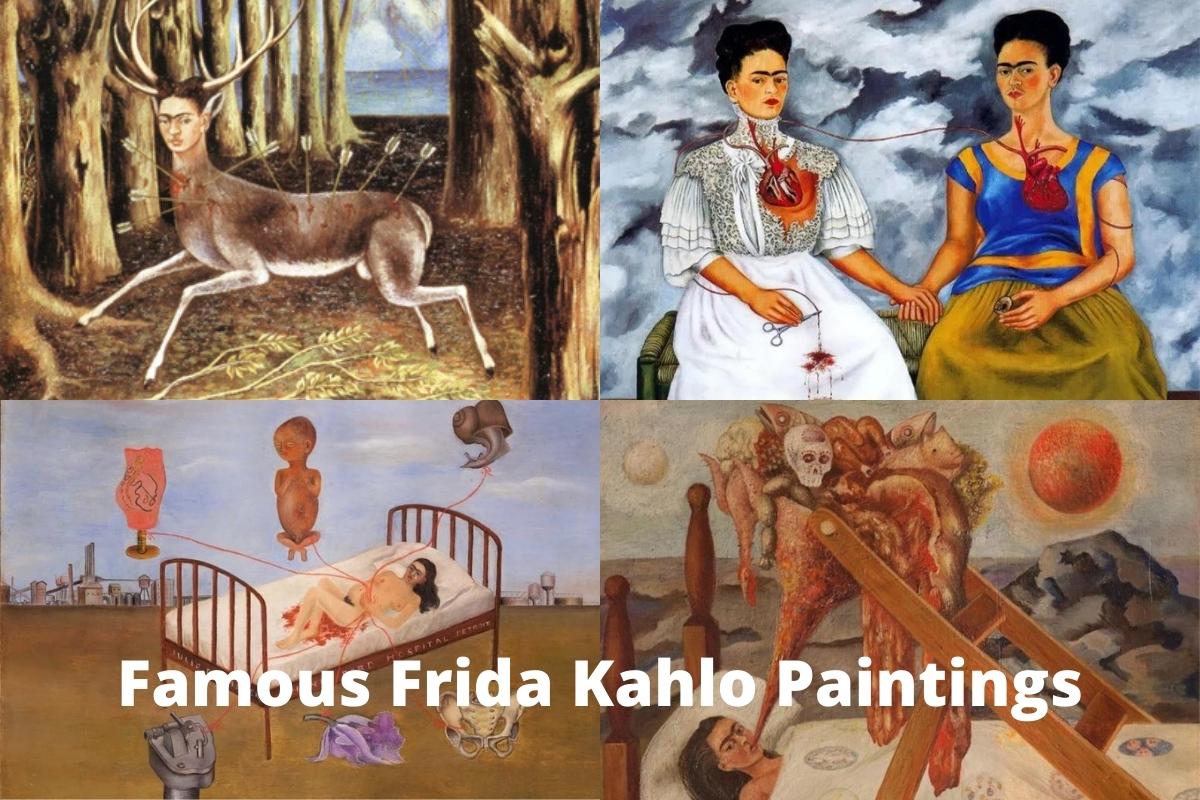Frida Kahlo is regarded as one of Mexico’s most talented painters and a self-portrait master. Kahlo was born in Mexico City in 1907.
She recovered from polio as a child, but she walked with a limp due to the virus’s damage to her leg and foot.
Kahlo was a passenger on a bus that hit a streetcar in 1925. She was impaled by a railing and suffered from excruciating agony for the rest of her life.
The artist started to concentrate more on her paintings as she recovered from her injuries, and one of her pieces that portrays her horrible accident is The Broken Column (below)
Her tragic relationship with Diego Rivera, a fellow artist, inspired Love and Pain as a recurring motif in her work. Frida Kahlo became well-known for her use of surrealism, realism, and Marxism, and she is now regarded as a modern artist and a counter-cultural figure in Mexico.
Kahlo is regarded as a feminist icon who often probed her own bodily agony in her self-portraits.
Frida Kahlo’s Famous Paintings
1. The Two Fridas
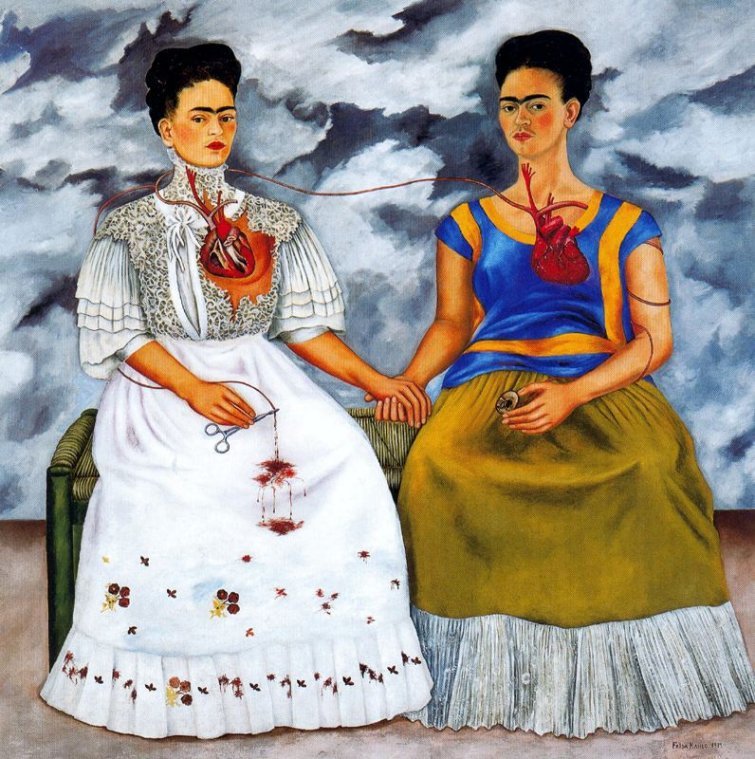
The Two Fridas is a weird yet thought-provoking picture of the dual nature of the society in which she and other Mexicans live at the time. The picture was completed in 1939 and depicts two versions of Kahlo reclining in an exquisite yet puzzling manner.
On the left, the visitor sees a portrayal of Kahlo wearing a European-style outfit that was popular among upper-class Mexicans at the time and also functioned as a symbol of luxury and richness.
The Kahlo on the right is dressed in a much more traditional Mexican clothing that has a lot more color than her opposite’s dazzling white attire.
According to the artist, the image depicts a nation split apart by the oncoming European influence of the day but yet adhering to the spirit of Mexican tradition.
We can easily identify where Kahlo’s heart is since her European-dressed counterpart has a bursting heart, but the Frida on the right has a heart that is alive and thriving.
2. The Broken Column
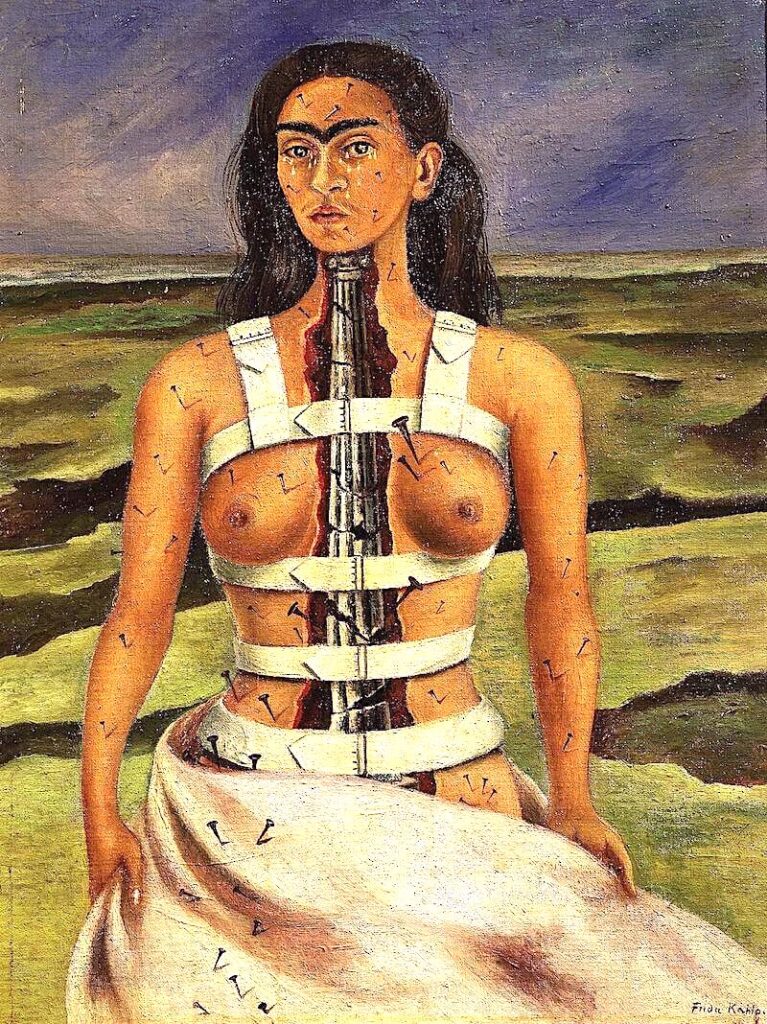
Frida Kahlo’s picture, The Broken Column, is another of her iconic self-portraits that invokes much more than superficial beauty.
In the summer of 1925, Kahlo was engaged in a major bus accident and would suffer with the intense agony and lingering injuries that ensued from the calamitous incident for the rest of her life.
She had to have more than 30 separate operations to correct some of the damage caused by the accident, and she was unable to conceive children as a result, which was reported to weigh heavily on her mind from that point forward.
The artwork was done in 1944, several years after the accident, yet it depicts a semi-naked Kahlo in a lovely white gown. Her body is covered with nails, which most likely represent the long-term suffering she endured as a result of the incident.
Her spine is shown as a shattered and crumbling column, and the backdrop of the artwork is a desolate landscape, implying that she was unable to bear children as a consequence of the disaster.
3. Self-Portrait with Thorn Necklace and Hummingbird
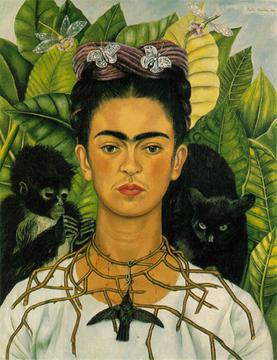
Frida Kahlo is well-known for her distinctive depictions of numerous people, most especially female figures, in which she often placed herself as the focal center of the picture.
Kahlo’s 1940 artwork, Self Portrait with Thorn Necklace and Hummingbird, is one of her most well-known self portraits.
She is seen in the artwork wearing a white dress or shirt, her body enveloped by thornbush branches that appear to engulf her head and shoulders.
In this picture, Kahlo is seen with her customary melancholy and slightly severe attitude as she stares back at the spectator. She also included some intriguing background images, such as a little monkey behind one shoulder and a black panther visible over the other.
Kahlo’s connection with indigenous Mexican culture influenced the look of her paintings. Kahlo situates herself in a legacy of struggle against colonial powers and patriarchal domination by using strong symbolism from indigenous Mexican culture.
Meanwhile, the black panther represents ill luck and death, while the monkey represents wickedness.
The natural scenery, which generally represents fertility, stands in stark contrast to the deathly images in the front.
Rivera gave Kahlo a spider monkey as a present, implying that it may be a symbol of Rivera, particularly as he inflicts agony on her by yanking on the thorn necklace hard enough to cause her to bleed.
Alternatively, the thorn necklace might be a reference to Christ’s crown of thorns, likening herself to a Christian martyr and expressing the sorrow and suffering she felt after her failed love engagements. According to this view, the butterflies and dragonflies may represent her resurrection.
4. Without Hope
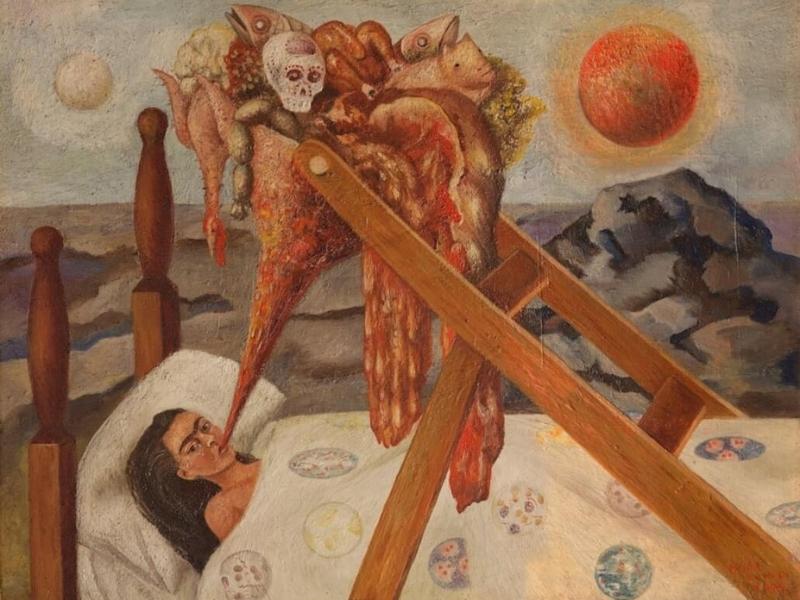
Not the least hope remains to me . . . Everything moves in time with what the belly dictates . . .” Frida wrote this line on the back of the picture in reference to the food routines she needed to follow in order to gain weight, since her lack of appetite had left her exceedingly thin.
Frida Kahlo created this picture in 1945, at a period of great physical difficulty for her. She experienced a loss of appetite as a result of the several ailments she had and the multiple operations she had to endure. This image, in reality, represents the restrictive diet that her doctor had advised for her.
5. The Wounded Deer
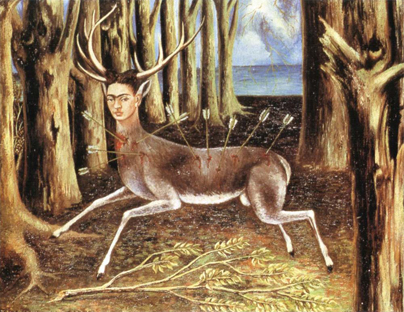
Kahlo, like she has done throughout her artistic career, conveys her continuing bodily and emotional anguish with her viewers via The Wounded Deer.
This artwork was painted at the end of Kahlo’s life, when her health was failing. To represent her many inspirations and beliefs, Kahlo blends pre-Columbian, Buddhist, and Christian motifs.
Kahlo depicts herself as an animal-human hybrid in The Wounded Deer. She possesses a deer’s body and antlers that extend from her own head. The deer is rising up, its legs spread in anticipation of action. Its right front leg is lifted off the ground, as if hurt or in motion.
Nine arrows are embedded in the deer’s body, producing wounds through which blood pours. The deer stands in the middle of a forest; nine trees are to the animal’s right, and a broken branch is in the foreground.
A broken branch is traditionally placed on a grave in Mexico. This is seen as an acknowledgment of the artist’s failing health. Despite the scars on the deer’s body, Kahlo paints a look of power rather than grief.
6. Henry Ford Hospital (The Flying Bed)
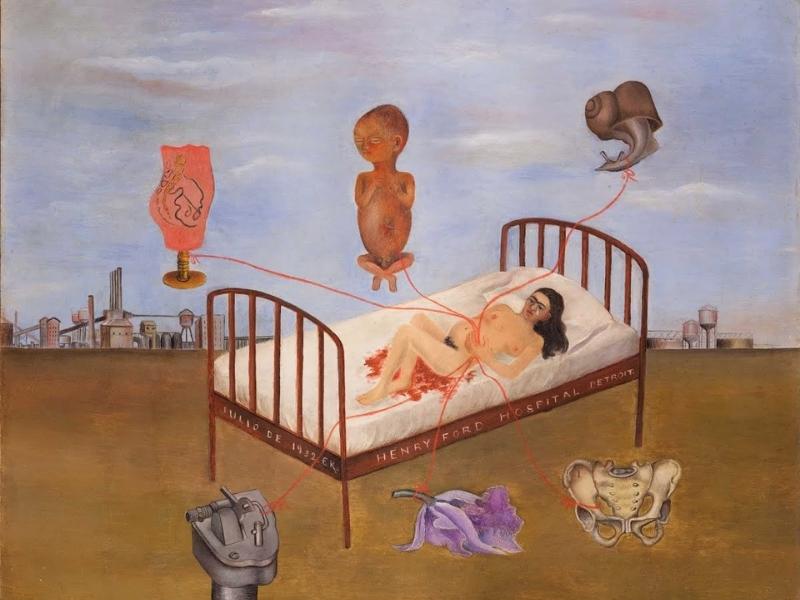
Frida experienced a miscarriage in Detroit on July 4, 1932, after being under the care of her physicians, who prescribed extended periods of full bed rest to bring her pregnancy to term.
Her body, on the other hand, was unable to fight and she was eventually transported to Henry Ford Hospital, where an abortion was done to complete the procedure that had began at home.
Some days later, in a profound despair, Frida requested that her child’s fetus be brought to her so that she might paint it. She was denied her request, and she had to make do with some images given by Diego and her physicians, with which she proceeded to produce this piece, named after the hospital where she was treated.
Medical pictures were used to create the visuals of a foetus, a pelvic bone, a female abdomen, and an orchid that mimics a uterus. The snail, she said, represented the slowness of the miscarriage, while the autoclave, a sixth item, is a device used to sterilize medical tools. The connection to sterility is most likely related to Kahlo’s personal infertility.
7. Viva la Vida, Watermelons
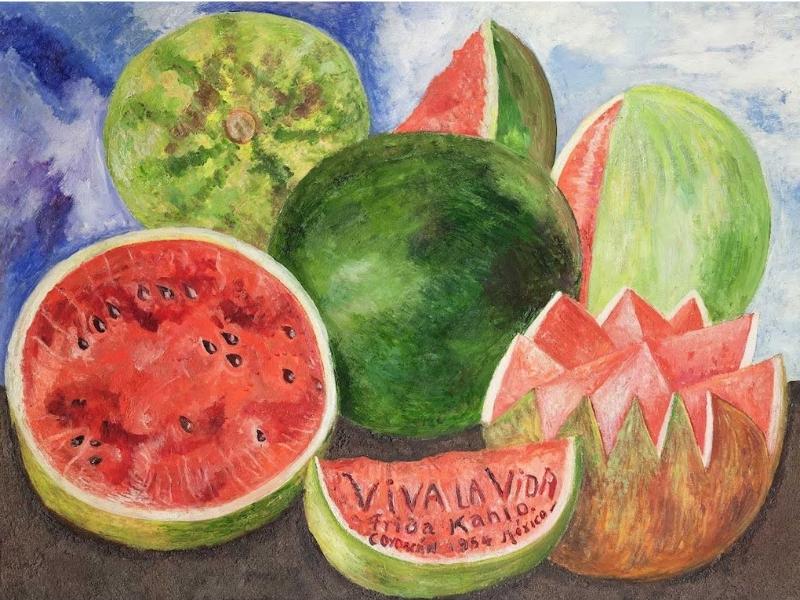
Kahlo’s last work, painted just before her death, was a still life with watermelons. The watermelon in Frida’s artwork has a lot of importance and is a common theme in Mexican art.
It is a famous emblem in the Dia de los Muertos (Day of the Dead) celebration, which often portrays watermelons being eaten by the dead or being presented in close proximity to the dead.
Eight days before her execution, she scribbled her name, the date, and the location of her execution on the melon’s scarlet pulp, along with the caption “VIVA LA VIDA – Coyoacán 1954 Mexico” in bold capital letters: Long Life Life!
8. Frieda and Diego Rivera
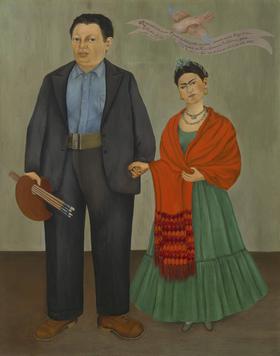
This image, which was painted two years after Frida Kahlo and Diego Rivera married, is usually regarded as a bridal portrait.
Rivera, Kahlo’s husband and fellow artist, is shown in the artwork. Rivera is shown as a painter, with a palette and four brushes in his right hand, while Kahlo tilts her head towards him.
Both are staring at the spectator, unsmiling. Kahlo’s left hand is clutching her brilliant red scarf. In the middle of the picture, Rivera and Kahlo are holding hands. Rivera towers above Kahlo in stature.
9. Self-Portrait with Cropped Hair
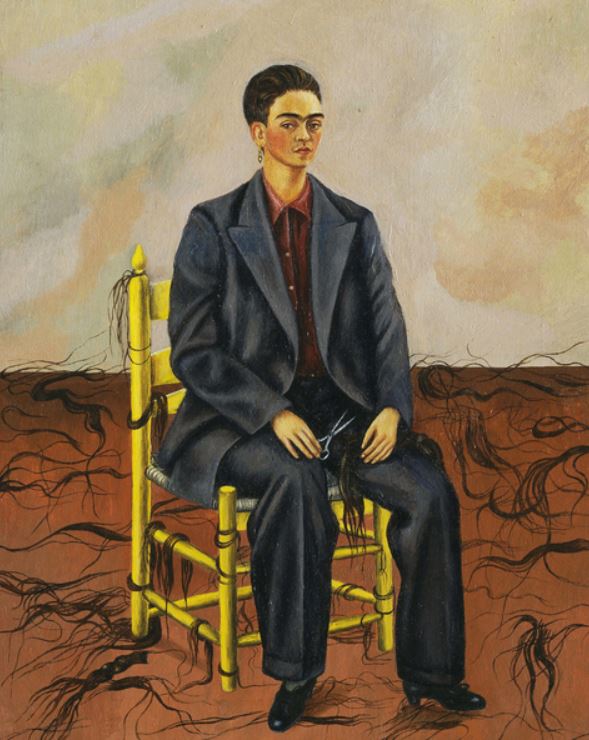
The artist’s difficult relationship with Diego Rivera, whom she married twice, was also a recurring motif in her work, and is represented in one of her iconic pictures taken soon after their divorce.
Frida’s first self-portrait following her divorce from Rivera was Self Portrait with Cropped Hair. She portrays herself in an enormous men’s suit and scarlet shirt, which contrasts sharply with her more traditional Mexican Tehuana outfits, which she often wears in her paintings.
She has shaved her long hair, which Diego was rumored to adore. As a symbol of her sacrifice, she holds a strand of her cropped hair in her left hand.
She wields the scissors with which she murdered her femininity with her right hand. Strands of her hair are everywhere, enveloping her in the empty space she seems to shrink into.
10. What the Water Gave Me
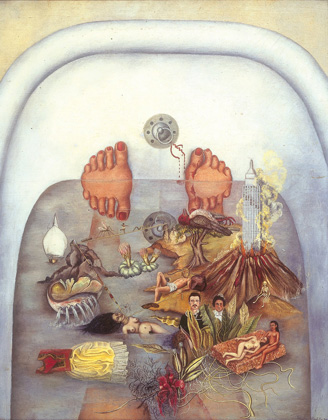
What the Water Gave Me (Lo que el agua me dio in Spanish) is a 1938 oil painting and is also known as What I Saw in the Water.
What the Water Gave Me has been referred to as her biography. She used this work to reflect on her life and recollections. Kahlo’s unconscious mind was unleashed by the use of what seems to be an unreasonable juxtaposition of pictures in her bathwater.
Frida depicts herself, namely her legs and feet, reclining in a bath of grey water in this painting.
In this image, Kahlo seems dead as she rests in a bathtub filled with water, her legs scarcely visible but her feet poking out. Her right foot is bleeding and distorted, a reflection of what was going on in her body when she was in anguish.
The artwork incorporates traditional and ancient iconography, mythology and symbolism, sensuality, and botany into a scenario representing the artist’s legs (as represented by her damaged right foot) soaked in bath water.

